Quantification of Two-Dimensional Wave Breaking Dissipation in the Surf Zone from Remote Sensing Data
Abstract
:1. Introduction
2. Methods
2.1. Wave Breaking Identification and Tracking
2.2. Dissipation Estimation
3. Experimental Data
4. Results
4.1. Breaking Detection
4.2. Roller Lengths and Dissipation Fields
5. Discussion
5.1. Validation
5.2. Sensitivity Analysis
6. Conclusions
Acknowledgments
Author Contributions
Conflicts of Interest
References
- Bonneton, P.; Bruneau, N.; Castelle, B.; Marche, F. Large-scale vorticity generation due to dissipating waves in the surf zone. Discret. Contin. Dyn. Syst. Ser. B 2010, 13, 729–738. [Google Scholar] [CrossRef]
- Longuet-Higgins, M.S.; Stewart, R. Radiation stresses in water waves; a physical discussion with applications. Deep Sea Res. 1964, 11, 529–562. [Google Scholar] [CrossRef]
- Longuet-Higgins, M.S. Longshore currents generated by obliquely incident sea waves: 1. J. Geophys. Res. 1970, 75, 6778–6789. [Google Scholar] [CrossRef]
- Holman, R.; Haller, M.C. Remote Sensing of the Nearshore. Ann. Rev. Mar. Sci. 2013, 5, 95–113. [Google Scholar] [CrossRef] [PubMed]
- Battjes, J.A. Surf-zone dynamics. Ann. Rev. Fluid Mech. 1988, 20, 257–293. [Google Scholar] [CrossRef]
- Battjes, J.A.; Janssen, J.P.F.M. Energy loss and set-up due to breaking random waves. In Proceedings of the 16th Conference on Coastal Engineering, Hamburg, Germany, 27 August–3 September 1978; pp. 68–81. [Google Scholar]
- Le Mehaute, B. On Non-Saturated Breakers and the Wave Run-Up. Available online: https://icce-ojs-tamu.tdl.org/icce/index.php/icce/article/view/2255 (accessed on 26 December 2017).
- Warner, J.C.; Armstrong, B.; He, R.; Zambon, J.B. Development of a Coupled Ocean-Atmosphere-Wave-Sediment Transport (COAWST) Modeling System. Ocean Model. 2010, 35, 230–244. [Google Scholar] [CrossRef]
- Roelvink, D.; Reniers, A.; van Dongeren, A.; van Thiel de Vries, J.; McCall, R.; Lescinski, J. Modelling storm impacts on beaches, dunes and barrier islands. Coast. Eng. 2009, 56, 1133–1152. [Google Scholar] [CrossRef]
- Zijlema, M.; Stelling, G.; Smit, P. SWASH: An operational public domain code for simulating wave fields and rapidly varied flows in coastal waters. Coast. Eng. 2011, 58, 992–1012. [Google Scholar] [CrossRef]
- Shi, F.; Kirby, J.T.; Harris, J.C.; Geiman, J.D.; Grilli, S.T. A high-order adaptive time-stepping TVD solver for Boussinesq modeling of breaking waves and coastal inundation. Ocean Model. 2012, 43–44, 36–51. [Google Scholar] [CrossRef]
- Ma, G.; Shi, F.; Kirby, J.T. Shock-capturing non-hydrostatic model for fully dispersive surface wave processes. Ocean Model. 2012, 43–44, 22–35. [Google Scholar] [CrossRef]
- Duncan, J. An experimental investigation of breaking waves produced by a towed hydrofoil. Proc. R. Soc. Lond. A 1981, 377, 331–348. [Google Scholar] [CrossRef]
- Svendsen, I.A. Mass flux and undertow in the surf zone. Coast. Eng. 1984, 8, 347–365. [Google Scholar] [CrossRef]
- Melville, W.K.; Loewen, M.R.; Felizardo, F.C.; Jessup, A.T.; Buckingham, M.J. Acoustic and microwave signatures of breaking waves. Nature 1988, 336, 54–56. [Google Scholar] [CrossRef]
- Holman, R.; Stanley, J. The history and technical capabilities of Argus. Coast. Eng. 2007, 54, 477–491. [Google Scholar] [CrossRef]
- Catalán, P.A.; Haller, M.C.; Plant, W.J. Microwave Backscattering from Surf Zone Waves. J. Geophys. Res. 2014, 119, 3098–3120. [Google Scholar] [CrossRef]
- Jessup, A.T.; Zappa, C.J.; Loewen, M.R.; Hesany, V. Infrared remote sensing of breaking waves. Nature 1997, 385, 52–55. [Google Scholar] [CrossRef]
- Lehner, S.; Pleskachevsky, A.; Velotto, D.; Jacobsen, S. Meteo-Marine Parameters and Their Variability: Observed by High-Resolution Satellite Radar Images. Oceanography 2013, 26, 80–91. [Google Scholar] [CrossRef] [Green Version]
- Svendsen, I.A. Wave heights and set-up in a surf zone. Coast. Eng. 1984, 8, 303–329. [Google Scholar] [CrossRef]
- Nairn, R.B.; Roelvink, J.; Southgate, H.N. Transition zone with and implications for modelling surfzone hydrodynamics. In Proceedings of the 22nd International Conference on Coastal Engineering, Delft, The Netherlands, 2–6 July 1990; pp. 68–81. [Google Scholar]
- Stive, M.J.; De Vriend, H.J. Shear stresses and mean flow in shoaling and breaking waves. In Proceedings of the 24th International Conference on Coastal Engineering, Kobe, Japan, 23–28 October 1994; pp. 594–608. [Google Scholar]
- Dally, W.R.; Brown, C.A. A modeling investigation of the breaking wave roller with application to cross-shore currents. J. Geophys. Res. 1995, 100, 24873–24883. [Google Scholar] [CrossRef]
- Haller, M.C.; Catalán, P.A. Remote sensing of wave roller lengths in the laboratory. J. Geophys. Res. 2009, 114. [Google Scholar] [CrossRef]
- Díaz Méndez, G.M.; Haller, M.C.; Raubenheimer, B.; Elgar, S.; Honegger, D.A. Radar Remote Sensing Estimates of Waves and Wave Forcing at a Tidal Inlet. J. Atmos. Ocean. Technol. 2015, 32, 842–854. [Google Scholar] [CrossRef]
- Carini, R.J.; Chickadel, C.C.; Jessup, A.T.; Thomson, J. Estimating wave energy dissipation in the surf zone using thermal infrared imagery. J. Geophys. Res. Oceans 2015, 120, 3937–3957. [Google Scholar] [CrossRef]
- Flores, R.P.; Catalán, P.; Haller, M.C. Estimating surfzone wave transformation and wave setup from remote sensing data. Coast. Eng. 2016, 114, 244–252. [Google Scholar] [CrossRef]
- Catalán, P.A.; Haller, M.C.; Holman, R.A.; Plant, W.J. Optical and Microwave Detection of Surf Zone Breaking Waves. IEEE Trans. Geosci. Remote Sens. 2011, 49, 1879–1893. [Google Scholar] [CrossRef]
- Thornton, E.B.; Guza, R.T. Transformation of wave height distribution. J. Geophys. Res. 1983, 88, 5925–5938. [Google Scholar] [CrossRef]
- Thomson, J. Wave Breaking Dissipation Observed with “SWIFT” Drifters. Am. Meteorol. Soc. 2012, 29, 1866–1882. [Google Scholar] [CrossRef]
- Clark, D.B.; Elgar, S.; Raubenheimer, B. Vorticity generation by short-crested wave breaking. Geophys. Res. Lett. 2012, 39. [Google Scholar] [CrossRef]
- Booij, N.; Ris, R.C.; Holthuijsen, L.H. A third-generation wave model for coastal regions 1. Model description and validation. J. Geophys. Res. 1999, 104, 7649–7666. [Google Scholar] [CrossRef]
- Chen, Q.; Kirby, J.T.; Dalrymple, R.A.; Kennedy, A.B.; Chawla, A. Boussinesq modeling of wave transformation, breaking and runup, II:2D. J. Waterw. Port Coast. Ocean Eng. 2000, 126, 48–56. [Google Scholar] [CrossRef]
- Cienfuegos, R.; Barthélemy, E.; Bonneton, P. Wave-Breaking Model for Boussinesq-Type Equations Including Roller Effects in the Mass Conservation Equation. J. Waterw. Port Coast. Ocean Eng. 2010, 136, 10–26. [Google Scholar] [CrossRef]
- Deigaard, R. A note on the three-dimensional shear stress distribution in a surf zone. Coast. Eng. 1993, 20, 157–171. [Google Scholar] [CrossRef]
- Smith, J.A. Wave-current interactions in finite depth. J. Phys. Oceanogr. 2006, 36, 1403–1419. [Google Scholar] [CrossRef]
- Haller, M.C.; Honegger, D.; Catalán, P.A. Rip Current Observations via Marine Radar. J. Waterw. Port Coast. Ocean Eng. 2014, 140, 115–124. [Google Scholar] [CrossRef]
- Buhr Hansen, J. Periodic waves in the surf zone: Analysis of experimental data. Coast. Eng. 1990, 14, 19–41. [Google Scholar] [CrossRef]
- Zhang, C.; Zhang, Q.; Zheng, J.; Demirbilek, Z. Parameterization of nearshore wave front slope. Coast. Eng. 2017, 127, 80–87. [Google Scholar] [CrossRef]
- Reniers, A.; Battjes, J. A laboratory study of longshore currents over barred and non-barred beaches. Coast. Eng. 1997, 30, 1–22. [Google Scholar] [CrossRef]
- Ruessink, B.G.; Miles, J.R.; Feddersen, F.; Guza, R.T.; Elgar, S. Modeling the alongshore current on barred beaches. J. Geophys. Res. 2001, 106, 22451–22463. [Google Scholar] [CrossRef]
- MacMahan, J.H.; Thornton, E.B.; Reniers, A.J. Rip current review. Coast. Eng. 2006, 53, 191–208. [Google Scholar] [CrossRef] [Green Version]
- Wilson, G.W.; Özkan-Haller, H.T.; Holman, R.A.; Haller, M.C.; Honegger, D.A.; Chickadel, C.C. Surf zone bathymetry and circulation predictions via data assimilation of remote sensing observations. J. Geophys. Res. Oceans 2014, 119, 1993–2016. [Google Scholar] [CrossRef]
- Mei, C.C. The Applied Dynamics of Ocean Surface Waves; Wiley: New York, NY, USA, 1983. [Google Scholar]
- Long, C.E. Index and Bulk Parameters for Frequency-Directional Spectra Measured at CERC Field Research Facility, July 1994 to August 1995; Miscellaneous Paper CERC-96-6; U.S. Army Corps of Engineers, Waterways Experiment Station: Vicksburg, MS, USA, 1996. [Google Scholar]
- Svendsen, I.A.; Putrevu, U. Nearshore circulation with 3-D profiles. In Proceedings of the 22nd International Coastal Engineering Conference, Delft, The Netherlands, 2–6 July 1990; pp. 241–254. [Google Scholar]
- Feddersen, F.; Guza, R.T. Observations of nearshore circulation: Alongshore uniformity. J. Geophys. Res. Oceans 2003, 108, 6-1–6-10. [Google Scholar] [CrossRef]
- Smith, S.D. Coefficients for sea surface wind stress, heat flux, and wind profiles as a function of wind speed and temperature. J. Geophys. Res. 1988, 93, 15467–15472. [Google Scholar] [CrossRef]
- Peregrine, D. Surf Zone Currents. Theor. Comput. Fluid Dyn. 1998, 10, 295–309. [Google Scholar] [CrossRef]
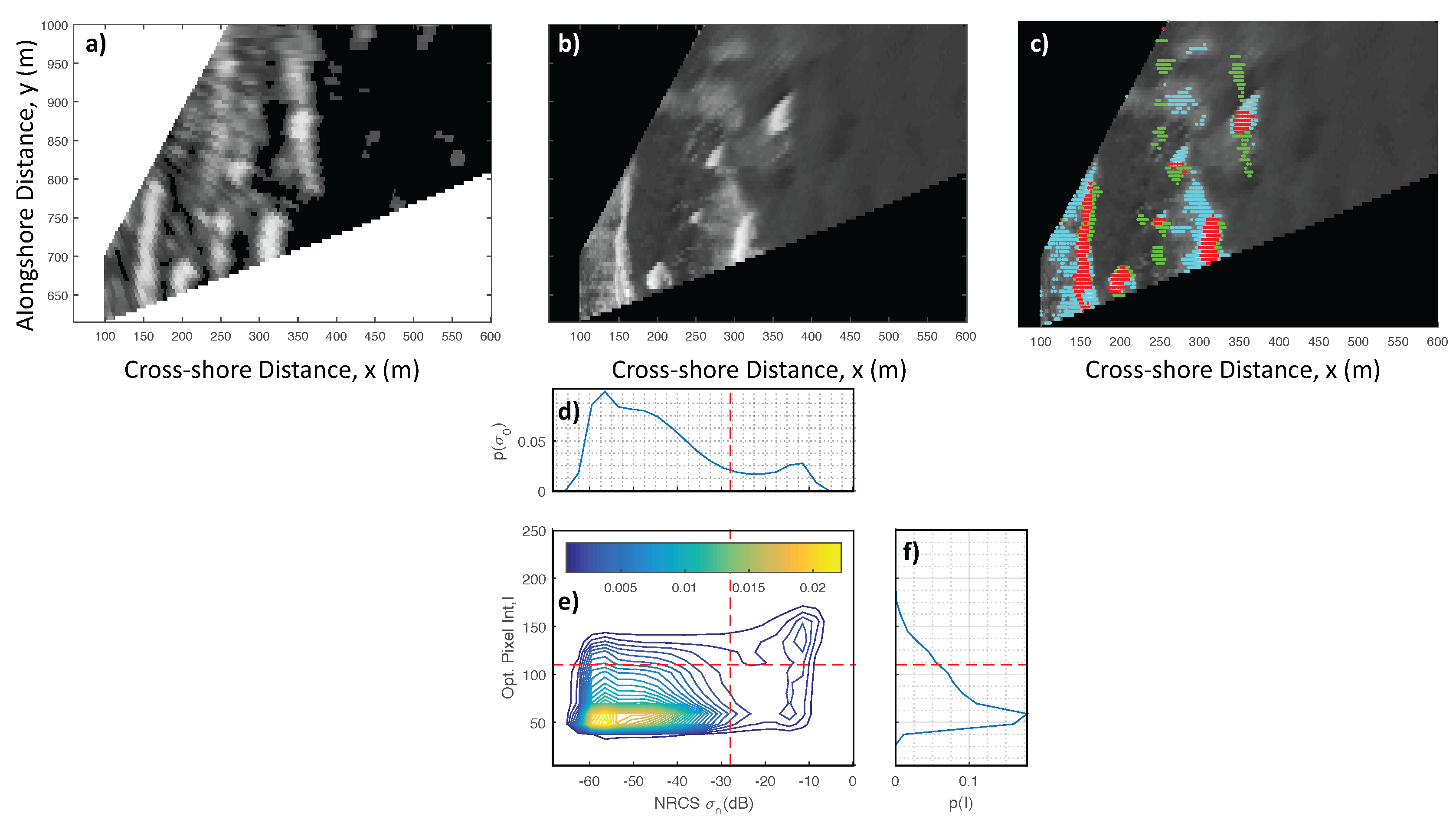

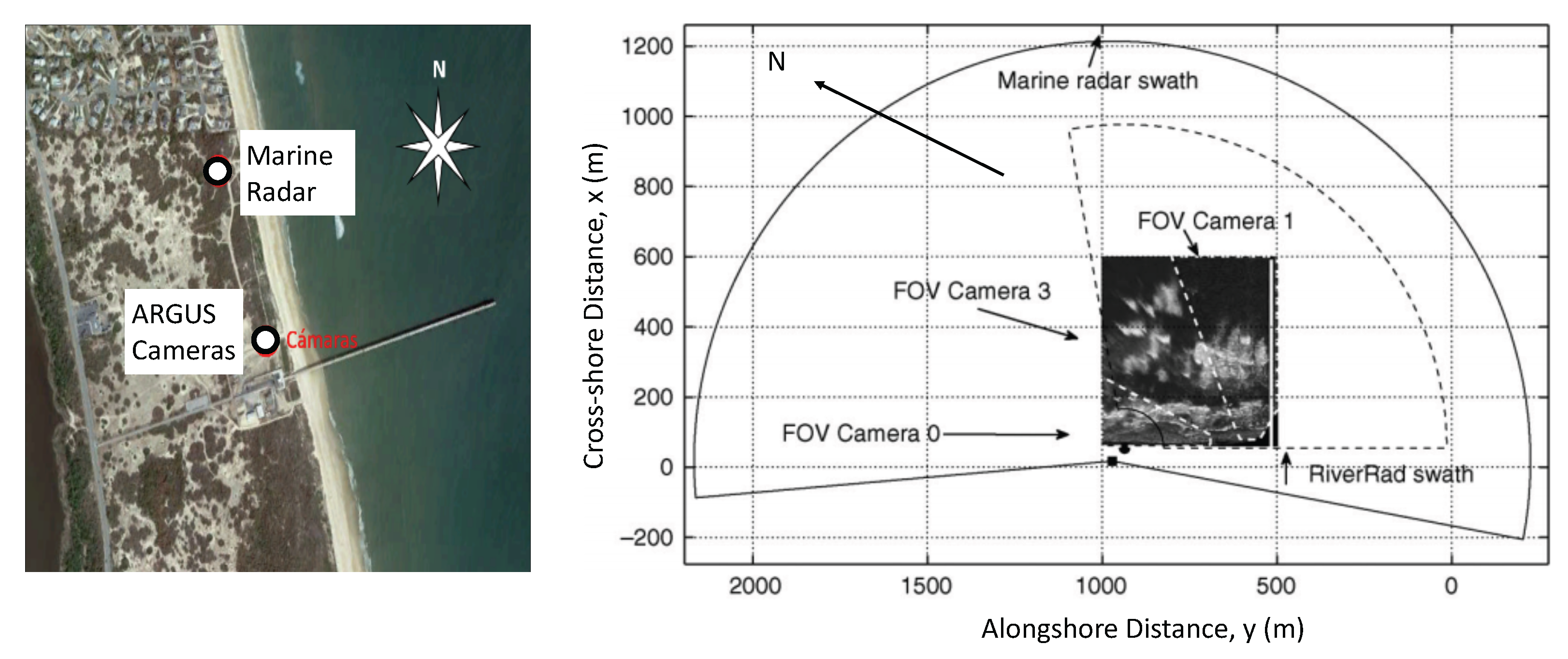
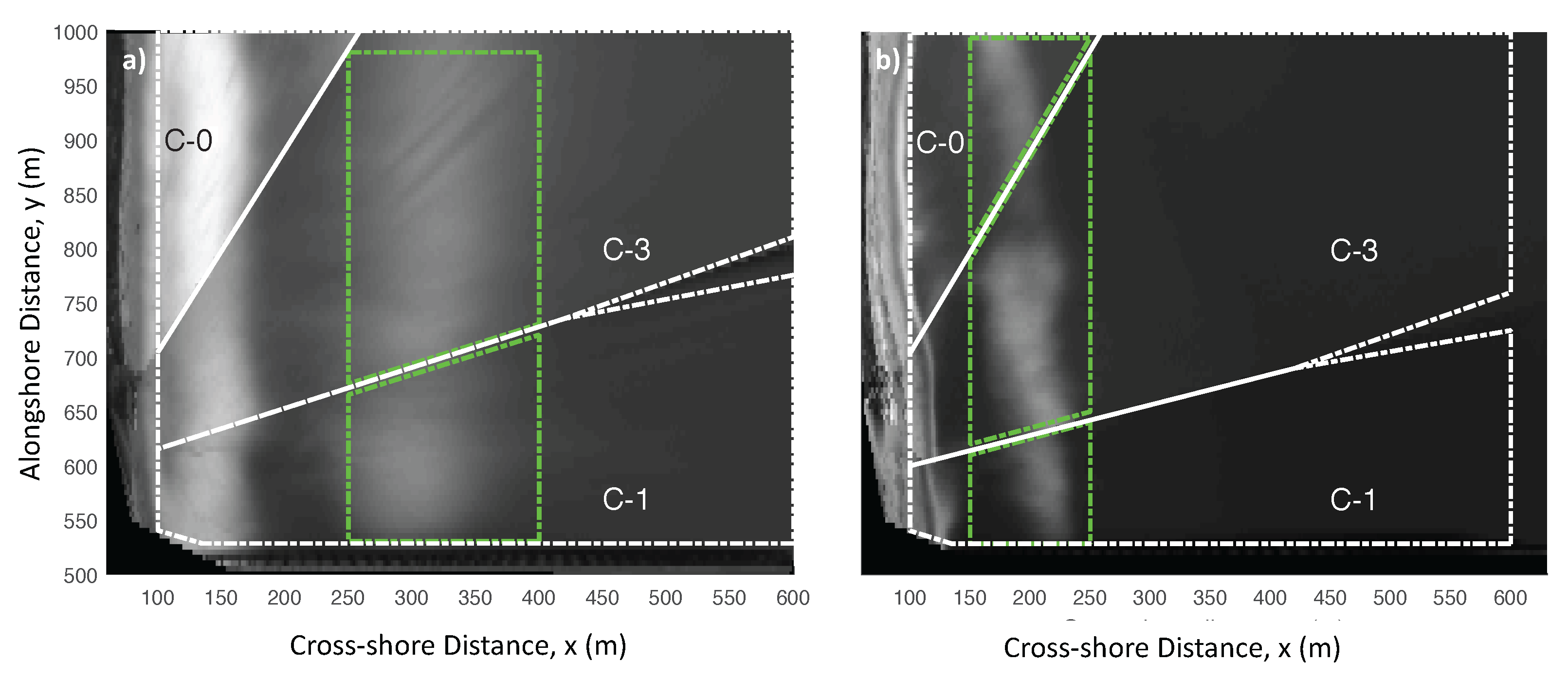

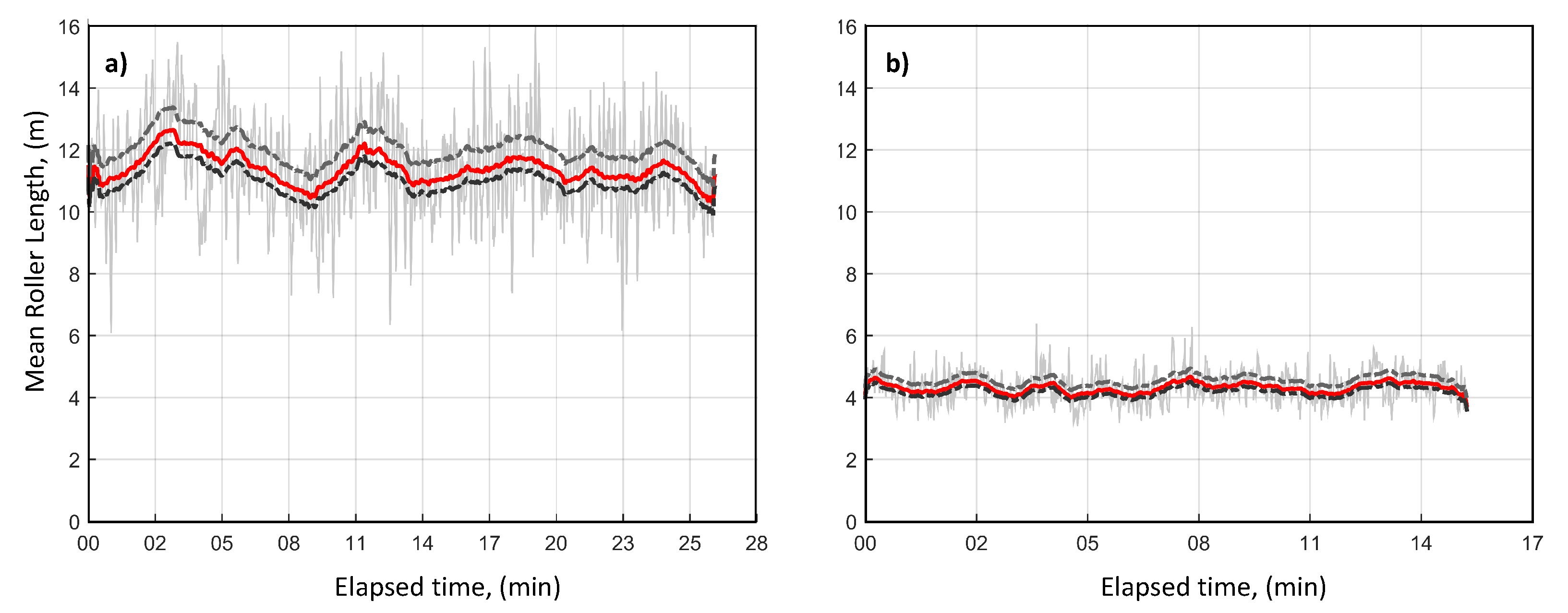

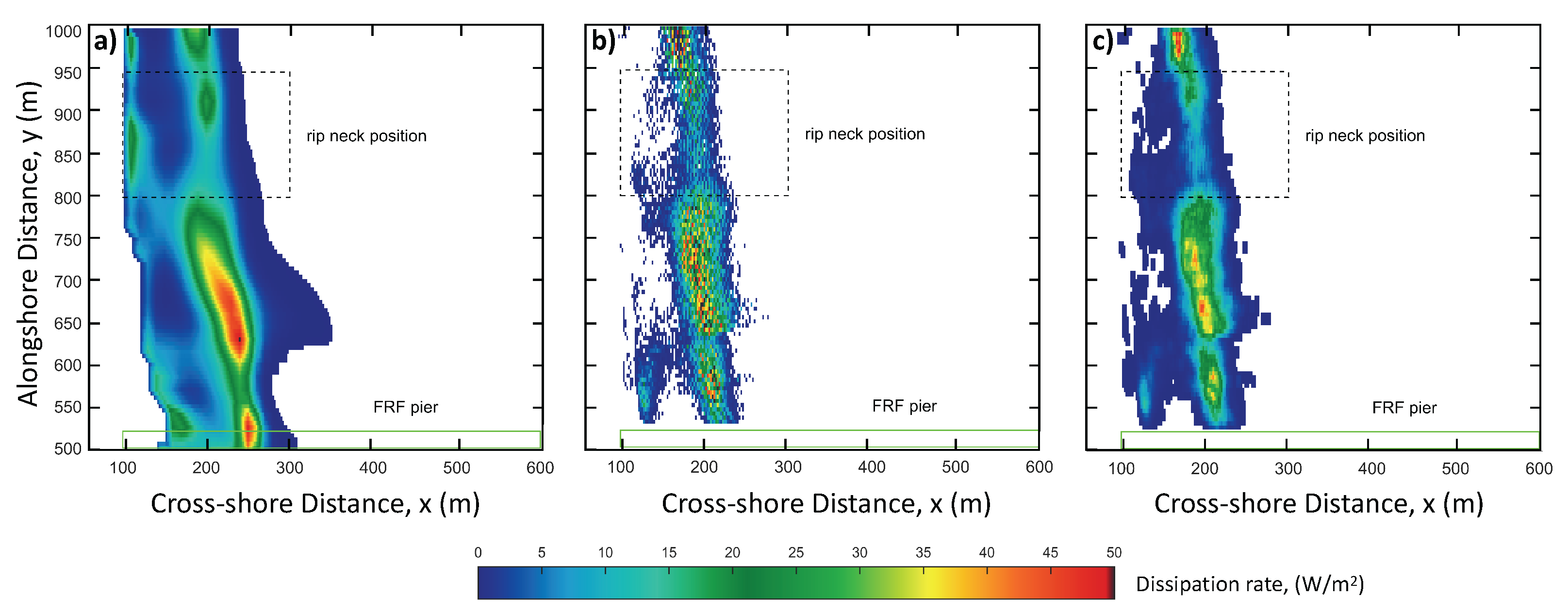
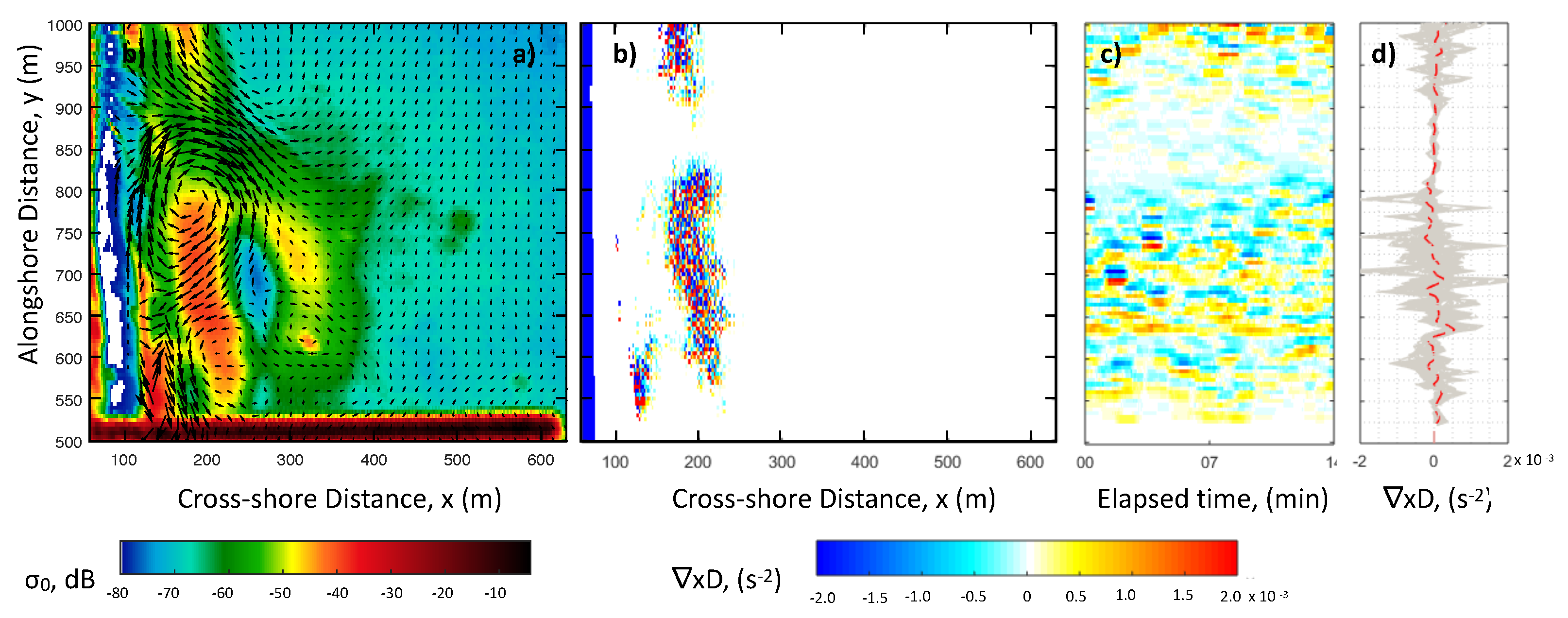
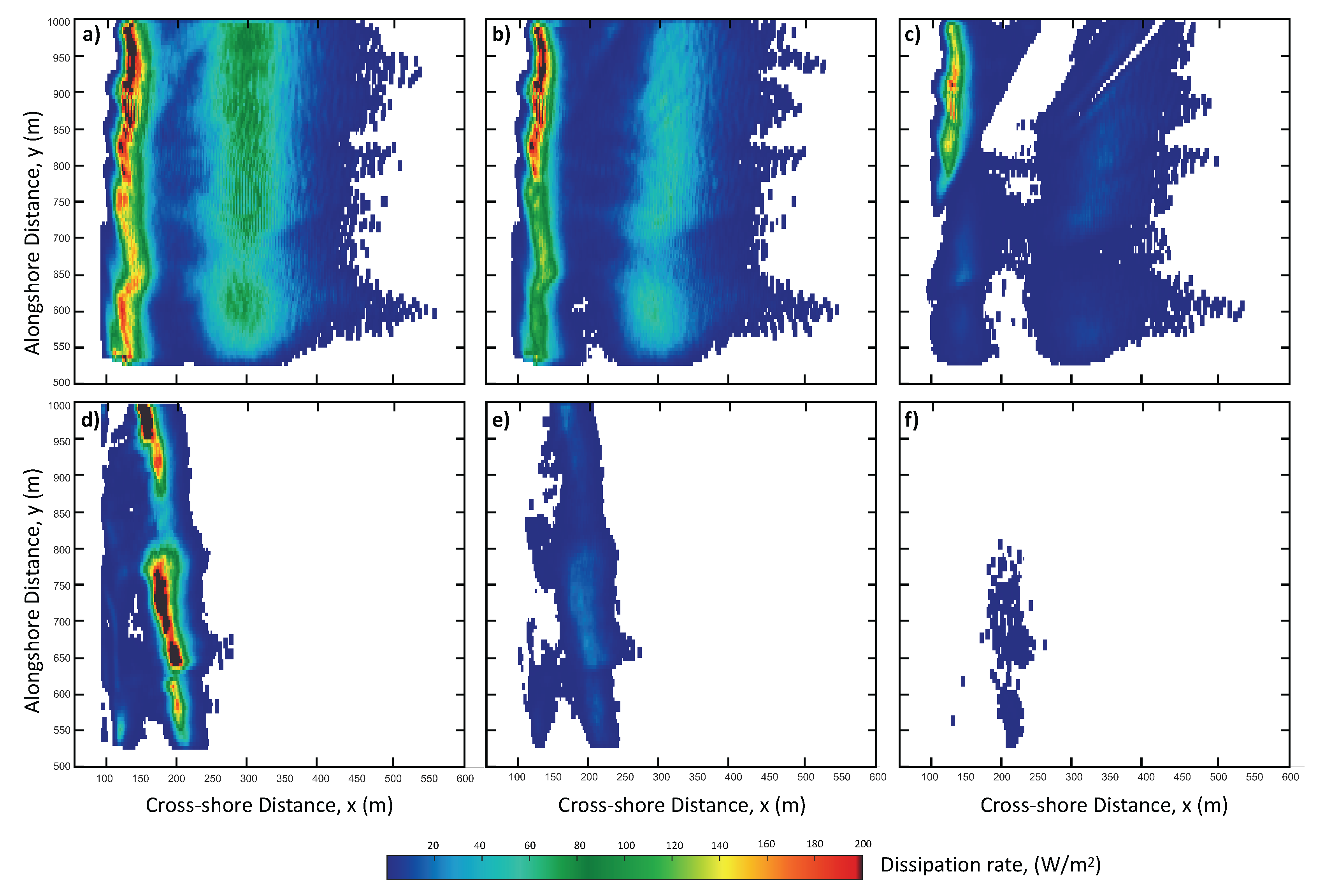
| Dataset | (s) | (m) | MWD (FRF) | Tide (m) |
|---|---|---|---|---|
| R1 | 12.7 | 1.9 | 5 | 0.7 (Mid tide) |
| R2 | 5.8 | 0.7 | −22 | −0.1 (Low tide) |
| Dataset | Cam0 | Cam1 | Cam3 |
|---|---|---|---|
| R1 | - | 85 | 89 |
| R2 | 103 | 80 | 103 |
| Dataset | Variable Instrument | Min Value | Mid Value | Max Value | Fixed Instrument | Value |
|---|---|---|---|---|---|---|
| R1 | Camera | 50 | 100 | 150 | Radar | −28 dB |
| R2 | Radar | −50 dB | −28 dB | −15 dB | Camera | 103 |
© 2017 by the authors. Licensee MDPI, Basel, Switzerland. This article is an open access article distributed under the terms and conditions of the Creative Commons Attribution (CC BY) license (http://creativecommons.org/licenses/by/4.0/).
Share and Cite
Díaz, H.; Catalán, P.A.; Wilson, G.W. Quantification of Two-Dimensional Wave Breaking Dissipation in the Surf Zone from Remote Sensing Data. Remote Sens. 2018, 10, 38. https://doi.org/10.3390/rs10010038
Díaz H, Catalán PA, Wilson GW. Quantification of Two-Dimensional Wave Breaking Dissipation in the Surf Zone from Remote Sensing Data. Remote Sensing. 2018; 10(1):38. https://doi.org/10.3390/rs10010038
Chicago/Turabian StyleDíaz, Harold, Patricio A. Catalán, and Greg W. Wilson. 2018. "Quantification of Two-Dimensional Wave Breaking Dissipation in the Surf Zone from Remote Sensing Data" Remote Sensing 10, no. 1: 38. https://doi.org/10.3390/rs10010038





